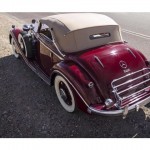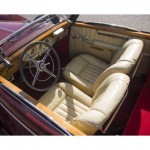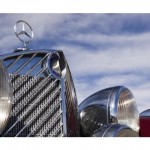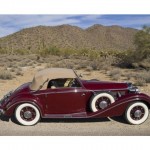From my perspective, watching auctions like Barrett-Jackson has always been a bit of detachment from reality. The numbers thrown at cars over the past decade are simply unfathomable to most and somewhat laughable at the same time. The frenzied auctions for economy cars with truck motors in them have been staggering; simply being witness to the Hemi ‘Cuda insanity was astonishing. In many ways, it strikes me as a historian much like the famed “Tulip Mania” in 1600s Netherlands. Speculation on the value of tulips reached the point where a single tulip bulb was worth around 10-15 times the average worker’s salary. For a flower. The resulting semi-insanity ended up partially ruining the Dutch economy, though it was not solely to blame and leaves out many other events that transpired. To me, watching shows like “Antiques Roadshow” often raises similar issues. In particular, recently the show has revisited older shows to display updated appraisals. In general, nearly all of the speculated values a decade on are lower, sometimes significantly. There’s one area that isn’t though – the Asian market, which if anything is much stronger than it was a decade ago thanks to the surging Chinese economy. For some time, the focus on muscle cars eclipsed the old money; very special coach-built pre-War cars used to be where the go-to value was. And while the E30 may be a flash in the pan with people lamenting when they could have bought an example for $10,000 that’s now worth 4 times that, consider this: in 1956, someone bought a Mercedes-Benz 540K special roadster for $2,167 (about $18,600 today). The last one that sold cleared $7.85 million dollars. How’s that for a good investment?
CLICK FOR DETAILS: 1938 Mercedes-Benz 540K Cabriolet A on eBay
Year: 1938
Model: 540K Cabriolet A
Engine: 5.4 liter supercharged inline-8
Transmission: 4-speed manual
Mileage: Doesn’t matter.
Price: If you have to ask….
1938 Mercedes-Benz 540K Cabriolet ‘A’
Coachwork by Sindelfingen
Chassis no. 169396
5.4-liter supercharged inline eight-cylinder
Four-speed manual transmission
Servo-assisted hydraulic brakesDelightful patina
Two long-term owners
One of 83 540K Cabriolet ‘A’ builtTogether with its predecessor the 500K, the magnificent Mercedes-Benz 540K was arguably the most noteworthy production model offered by the Stuttgart firm during the 1930s.
A development of the 500K, whose independently suspended chassis it shared, the 540K was powered by a 5.4-liter supercharged straight-eight engine. The 540K was one of the first models developed under Mercedes’ new chief engineer, ex-racing driver Max Sailer, successor to Hans Nibel, who had died in November 1934 at only 54 years old. It featured the company’s famous Roots-type supercharger system in which pressing the accelerator pedal to the end of its travel would simultaneously engage the compressor and close off the alternative atmospheric intake to the carburetor. This system had been thoroughly proven on the preceding series of Dr Porsche-conceived S-Type cars, and in effect the 540K was the last supercharged production Mercedes until relatively recent times.
Launched at the Paris Salon in October 1936, the 540K had an engine that developed 115bhp un-supercharged or 180bhp with the compressor engaged. The gearbox was a four-speed, but with a direct top gear rather than the overdrive ratio used on the earlier 500K. With the supercharger engaged, the 540K’s blown straight-eight gave it a top speed approaching 110mph (177km/h) matched by servo-assisted hydraulic braking. Its performance potential was such that Mercedes-Benz in the UK retained racing driver Goffredo ‘Freddy’ Zehender as technical adviser and demonstration driver, since the supercharged Mercedes was one of the few genuine 100mph road cars available in the 1930s.
Tested by Britain’s Motor magazine, the 540K was deemed to have lighter steering and handling than its 500K predecessor, plus an even more comfortable ride, even though the same all-round independent suspension layout with parallel links and coil springs at the front and swing axles at the rear was retained. The Motor’s test car returned 102mph over the timed quarter-mile with the supercharger engaged and 85mph with it disengaged. Such performance was achieved at the cost of 11mpg petrol consumption, but the servo-assisted brakes came in for fulsome praise, the blower was found to be relatively quiet, and the steering and handling also compared favorably with the 500K.
In May 1938, the 540K was tested by Motor’s rival magazine Autocar and achieved the highest maximum speed of any road-test car up to that date: carrying three passengers, the car reached 104.65 mph (168.5km/h) on the race circuit at Brooklands, Surrey. “One’s foot goes hard down, and an almost demoniacal howl comes in,” reported test driver H. S. Linfield. “The rev counter and speedometer needles leap round their dials: there is perhaps no other car noise in the world so distinctive as that produced by the Mercedes supercharger.”
Late in 1938, a revised 540K made its appearance, with oval-section chassis tubes instead of channel frame members, while the adoption of sodium-cooled valves followed the company’s highly successful racing practice.
Although the 500K/540K chassis attracted the attention of many of the better quality bespoke coachbuilders of the day, Mercedes’ own Sindelfingen coachwork left little room for improvement. The cabriolet came in a variety of styles. This example has the Cabriolet ‘A’ option with two-door, 2+1 seater coachwork and is outstandingly handsome, boasting wire wheels, twin side-mounted spares, exposed landau irons, twin horns and a center spotlight. The work of the gifted Hermann Ahrens, design chief at Sindelfingen, the Cabriolet ‘A’ offered elegant all weather touring allied to breathtaking performance.
Daimler-Benz’s order number 262498 was supplied with this car, chassis number 169396. It was one of at least two cars in this series delivered to Mercedes-Benz of Paris at that time, the next consecutive chassis 169397 (sold by Bonhams in 2005) also being delivered new through this agency. According to copies of the factory records, it was completed early in 1938 and transferred to Paris on March 20, 1938. We are not aware of records of its original purchaser at this time, but it is understood that like its sister car, shortly after the war the 540 was brought to the U.S. by an Army officer, Colonel William H. Kendall of Sarasota, Florida. Col. Kendall kept the car until 1970, when it passed to a friend of his, arch car sleuth Paul Karassik, the person credited with extracting two Auto Union Grand Prix cars from the Ukraine in the late 1980s. Karassik would keep the Mercedes for more than 40 years, the custodianship by these two long-term keepers therefore account for the vast majority of its life.
Early in this second period of U.S. custody the Mercedes was refurbished with new paint in the deep burgundy tone that it still wears to this day, at the same time its original leather was re-dyed, rather than replaced, and a new top was fitted. This remains the sum total of the work carried out on the car in the course of his ownership and with limited attention since, it remains in extremely original and authentic order. Correct period features include a rare round faced Becker Radio, fabric radiator cover to assist running in cold temperatures and a fold away luggage rack, among others.
Looking forward, the car may be considered as a solid driver quality car or alternatively a sound basis for a Concours style refurbishment.
The manufacturing record of the 540K revealed its exclusive nature: 97 being produced in 1936, 145 in 1937, 95 in 1938 and 69 in 1939 before the war ended series production (though three more were built up to July 1942). Of a total of just over 400 produced, Cabriolet A derivatives are thought to account for 83 examples, with a survival rates a little over half of that number.Not surprisingly, in recent decades, the rarity, style and performance of these big supercharged Mercedes have made them one of the most sought-after of all classic cars on the rare occasions they have come to the open market. Bonhams has the very fine tradition and honor of offering the world’s greatest supercharged Mercedes; this Cabriolet ‘A’, in its late model specification, represented the very best that money could buy in the late 1930s, and still does.
For more inforamtion please call Mort at 949-335-7474 ext 1.
While the “normal” 540K isn’t quite as sought after as the Special models, it’s nonetheless collector car royalty. One of my favorite aspects of my Silver Arrows dissertation was charting the sporting models within each company; clearly, Mercedes-Benz was the victor with arguably the most impressive gentleman’s sports car of the day. True, there were some outrageous single-number produced Bugattis and Alfa Romeos that might be more bite-the-back-of-your-hand beautiful, but the Mercedes-Benz was probably the best all-around package and since people really started collecting classic cars, they’ve always been towards the upper crust of value. This particular example has a really interesting history and is presented, amazingly, as more or a driver than a Concours car. Over the past decade there has been a refreshing trend of appreciating cars that can be used rather than just every-detail-perfect show items. If you want something truly special, the 540K won’t disappoint – but you’ll certainly pay for the exclusivity. At an eye-watering 1.8 million dollars, it’s on par with limited collectable sports cars like Ferraris, Cobras and even it’s own grandson 300SL Gullwing. But I’d argue that the 540K is much more special than any of those cars – a true stunning showpiece, a timeless classic, a car that separates true connoisseurs from those simply looking to jump on the nearest and most popular bandwagon.
-Carter











“The Motor’s test car returned 102mph over the timed quarter-mile with the supercharger engaged…”
Is this true?
Yes, but not how you’re thinking. Top speed test v. Acceleration test.
Doug, to further clarify, I found some figures on a rolling 1/4 mile 540K. sometimes called the “flying” quarter mile, there are quotes of 101 m.p.h. for the 540. I also found an old test at Goodwood where a 540 was tested without supercharger engaged, and it returned a high-teens rolling quarter mile time. Considering that the car weighed the best part of 4000 lbs, had skinny tires and 180 horsepower, there isn’t much likely hood that it could do a standing start 100 m.p.h. 1/4.
In looking around, I also found that this particular car supposedly hammered for $670,000 in 2012. Interesting!
That makes more sense. Thanks, Carter.